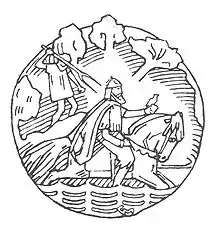Dag el Sabio
Dag el Sabio (n 403) (nórdico antiguo: Dagr Spaka) fue un rey vikingo legendario de Suecia de la Casa de Yngling, hijo de Dyggvi.[1][2] Dag, según la leyenda, podía entender el lenguaje de los pájaros y tenía un gorrión que reunía consigo noticias de todo el mundo y las compartía con el rey. Durante uno de esos viajes, el gorrión murió y Dag invadió Reidgotaland con su ejército de suiones (considerando la fecha y emplazamiento, presuntamente Gothiscandza) como venganza. Allí fue emboscado por un thrall (esclavo) y asesinado. Su figura protohistórica aparece en la saga Ynglinga, Ynglingatal[3] e Historia Norwegiæ.
| Dag el Sabio | ||
|---|---|---|
 | ||
| Información personal | ||
| Nacimiento |
Siglo III Gamla Uppsala (Suecia) | |
| Fallecimiento |
Siglo III Isla de Gotland (Suecia) | |
| Familia | ||
| Padre | Dyggvi | |
| Hijos | Agne | |
| Información profesional | ||
| Ocupación | Político | |
| Cargos ocupados | Rey semilegendario de Suecia | |
Según las versiones más primitivas de la historia que aparecen en Ynglingatal,[4] Historia Norwegiæ e Íslendingabók a Dag le sucedió en diarquía sus hijos Alrekr y Eírikr, que una vez llegado el turno, el trono lo recibió su nieto Agne (en Historia Norwegiæ llamado erróneamente Hogne).[5][6]
Íslendingabók cita una línea de descendencia en Ynglingatal y menciona a Dag como sucesor de Dyggvi y predecesor de Alrek: x Dyggvi. xi Dagr. xii Alrekr. xiii Agni. xiiii Yngvi.[7] Sin embargo en la saga Ynglinga, Snorri Sturluson menciona a Agne como hijo y sucesor de Dag, y los hermanos Alrek y Eirík como nietos.[8][9]
Referencias
- The Viking Age: the Early History, Manners, and Customs of the Ancestors of the English-speaking Nations: Illustrated from the Antiquiites Discovered in Mounds, Cairns, and Bogs as Well as from the Ancient Sagas and Eddas, Du Chaillu, Paul B. (Paul Belloni), (2 volumes. London : John Murray, 1889), FHL book 948 H2d; FHL film 1440113 items 1-2., vol. 1 p. 67.
- Der Europäischen käyser- und königlichen Häuser historische und genealogische Erläuterung (1730-1731), Lohmeier, Georg von, und Johann Ludwig Levin Gebhardi, (3 volumes in 1. Luneburg: Sternischen Buchdruckerei, 1730-1731), FHL microfilm 1,051,694, items 4-6., pt. 1 p. 137.
- Ynglingatal online
- Heimskringla: or the Lives of the Norse Kings, Sturluson, Snorri, (Cambridge, [England]: W. Heffer & Sons Ltd, 1932), FHL book 948 H2sa., p. 22.
- Storm, Gustav (editor) (1880). Monumenta historica Norwegiæ: Latinske kildeskrifter til Norges historie i middelalderen, Monumenta Historica Norwegiae (Kristiania: Brøgger), p. 99
- Ekrem, Inger (editor), Lars Boje Mortensen (editor) y Peter Fisher (trad.) (2003). Historia Norwegiæ. Museum Tusculanum Press. ISBN 8772898135, pp. 75-77.
- Íslendingabók ed. Guðni Jónsson
- Saga Ynglinga en Norrøne Tekster og Kvad
- Saga Ynglinga en sacred-texts.com
Bibliografía
- Nerman, B. Det svenska rikets uppkomst. Stockholm, 1925.
- Sturluson, Snorri; Lee M. Hollander (1964). Heimskringla: History of the Kings of Norway Lee Hollander. Austin: American-Scandinavian Foundation by the University of Texas Press. ISBN 0292730616.
Enlaces externos
- La Saga de los Ynglings y la Heimskringla en «Kulturformidlingen norrøne tekster og kvad». (en inglés y noruego)
| Predecesor: Dyggvi |
Reyes legendarios de Suecia Casa de Yngling |
Sucesor: Agne |